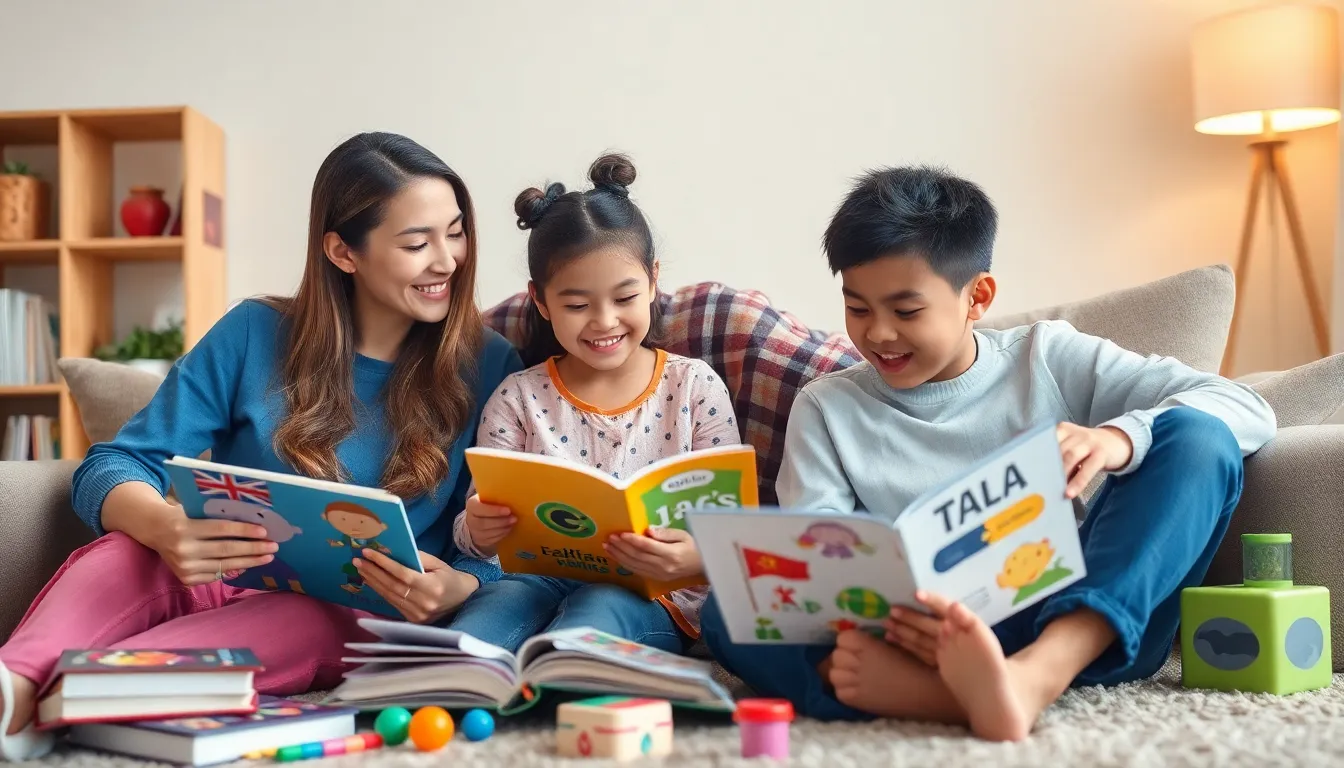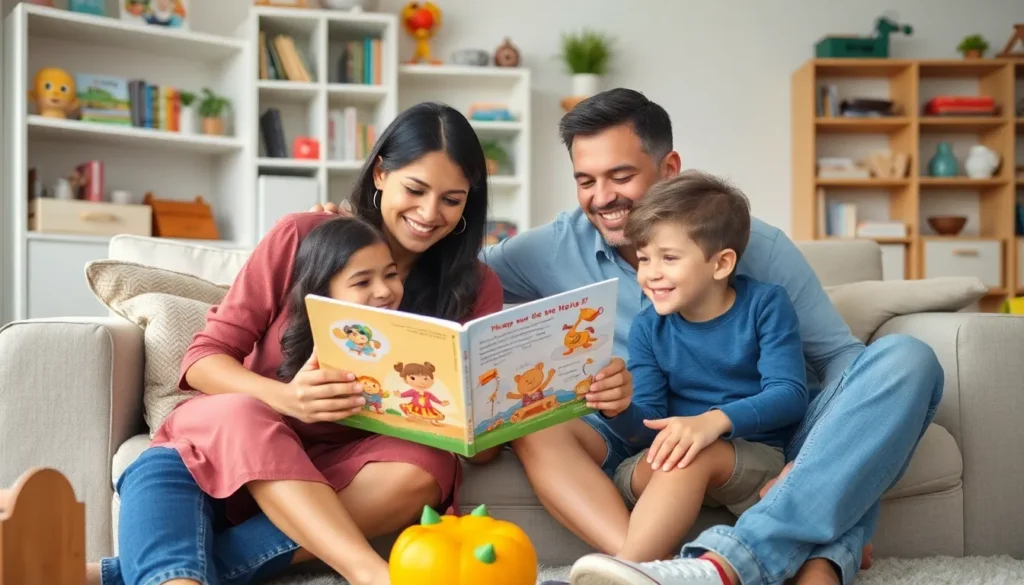Table of Contents
ToggleIn today’s multicultural world, language exposure within families plays a crucial role in shaping communication skills and cognitive development. Families that prioritize diverse language experiences give their children a unique advantage, fostering not just linguistic proficiency but also cultural awareness. This early exposure can create lifelong benefits, enhancing social interactions and academic success.
Understanding the dynamics of language exposure is essential for parents and caregivers aiming to nurture multilingual environments. By integrating various languages into daily routines, families can cultivate a rich tapestry of communication that supports children’s growth. This article delves into effective strategies for maximizing language exposure at home, ensuring children thrive in an increasingly interconnected society.
Understanding Language Exposure Family
Language exposure within families plays a crucial role in developing effective communication skills and cognitive abilities. Engaging children in diverse language experiences at home fosters linguistic proficiency and cultural awareness.
Definition of Language Exposure
Language exposure refers to the opportunities children encounter to hear, speak, and engage with different languages. This exposure can occur through conversations, books, songs, and multimedia resources. Increased exposure enhances vocabulary acquisition and grammatical understanding, facilitating proficiency in multiple languages. Research indicates that early and consistent language exposure correlates with improved cognitive abilities, including critical thinking and problem-solving skills.
Importance of Family in Language Development
Family dynamics significantly influence language development. Parents and caregivers serve as primary linguistic models, shaping children’s interactions and communication styles. Multilingual families provide a unique advantage, as children draw from diverse linguistic resources. Language-rich environments promote not only language skills but also emotional bonds and cultural identity. Studies show that children in supportive language environments exhibit higher academic achievement and enhanced social skills, demonstrating the long-term benefits of effective family language exposure.
Factors Affecting Language Exposure

Multiple factors influence language exposure in families, impacting children’s linguistic development. Variations in socioeconomic status and cultural background play significant roles in shaping the language environment.
Socioeconomic Status
Socioeconomic status affects access to language resources and educational opportunities. Families with higher incomes often afford language classes, books, and educational technology, facilitating enhanced exposure. For instance, children from affluent backgrounds may participate in multilingual programs, benefiting from immersions and bilingual schools. In contrast, lower-income families might experience limitations in accessing these resources, thereby reducing opportunities for rich language interaction. Studies show that children from higher socioeconomic backgrounds exhibit better language skills due to increased exposure and varied linguistic experiences.
Cultural Background
Cultural background strongly influences language exposure, as it dictates language use within the household. Families that embrace multiple languages often expose children to diverse linguistic practices and cultural traditions, enhancing their cognitive abilities. For example, children in bilingual families might thus learn structures and vocabulary from both languages, promoting flexibility in understanding. Additionally, cultural practices can encourage storytelling, music, and traditions in different languages, further enriching language exposure. Research indicates that robust cultural engagement alongside language exposure contributes to emotional security and identity development in multilingual children.
Strategies to Enhance Language Exposure in Families
Families can adopt various strategies to create a rich language environment at home. Engaging in interactive activities promotes better language acquisition and cognitive development.
Reading Together
Reading together strengthens language exposure and comprehension skills. Selecting diverse books in multiple languages encourages vocabulary expansion and cultural appreciation. Parents can incorporate storytelling sessions, allowing children to hear different accents and dialects. Implementing daily reading routines creates consistency, helping children associate language with positive experiences. Engaging children in discussions about stories fosters critical thinking and enhances language skills.
Interactive Communication
Interactive communication enhances language skills through real-time engagement. Encouraging open-ended questions during conversations promotes critical thinking and language use. Families can incorporate games that involve language, like word puzzles or storytelling games, to make learning enjoyable. Regular family meals present opportunities for discussions, allowing children to practice language skills in a social context. Using multimedia resources, such as audio recordings or apps, can supplement face-to-face communication, providing varied exposure to languages.
Benefits of a Rich Language Exposure Family Environment
A rich language exposure family environment offers numerous advantages for children’s development. Key benefits include enhanced cognitive abilities and improved social skills.
Cognitive Development
Cognitive development significantly benefits from rich language exposure. Research shows that children exposed to multiple languages exhibit better problem-solving abilities and heightened creativity. Engaging with diverse languages fosters neural connections associated with cognitive flexibility. Children develop stronger executive function skills, such as attention control and task switching, facilitating academic success. For instance, bilingual children often perform better on standardized tests due to advanced critical thinking capabilities linked to their language experiences.
Social Skills Improvement
Social skills improvement results from robust language exposure within family settings. Children learn to communicate effectively and develop empathy through interactions in various languages. Engaging in multilingual conversations enhances listening skills and promotes understanding of different cultural perspectives. This exposure leads to greater confidence in social situations and the ability to navigate diverse environments. For example, children raised in multilingual families may demonstrate heightened adaptability in making friends from different backgrounds.
Embracing language exposure within the family lays a strong foundation for children’s development. By prioritizing diverse linguistic experiences, families can nurture effective communication skills and cultural awareness. This approach not only enhances academic success but also fosters emotional bonds and social adaptability.
Implementing strategies like reading together and engaging in interactive conversations can significantly enrich children’s language environments. As families navigate their unique linguistic journeys, the benefits of multilingual exposure become evident, shaping confident and capable individuals ready to thrive in a diverse world.




